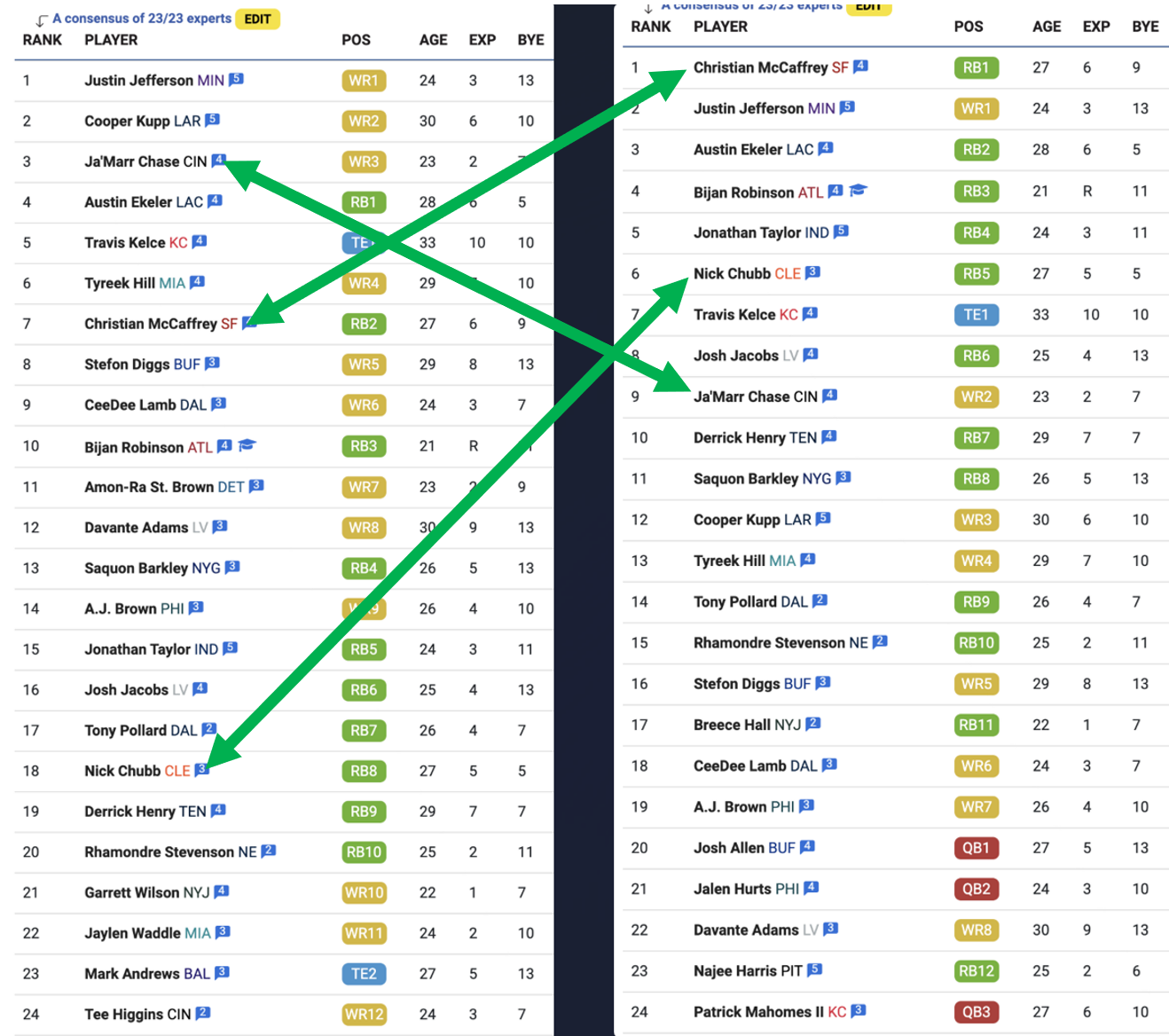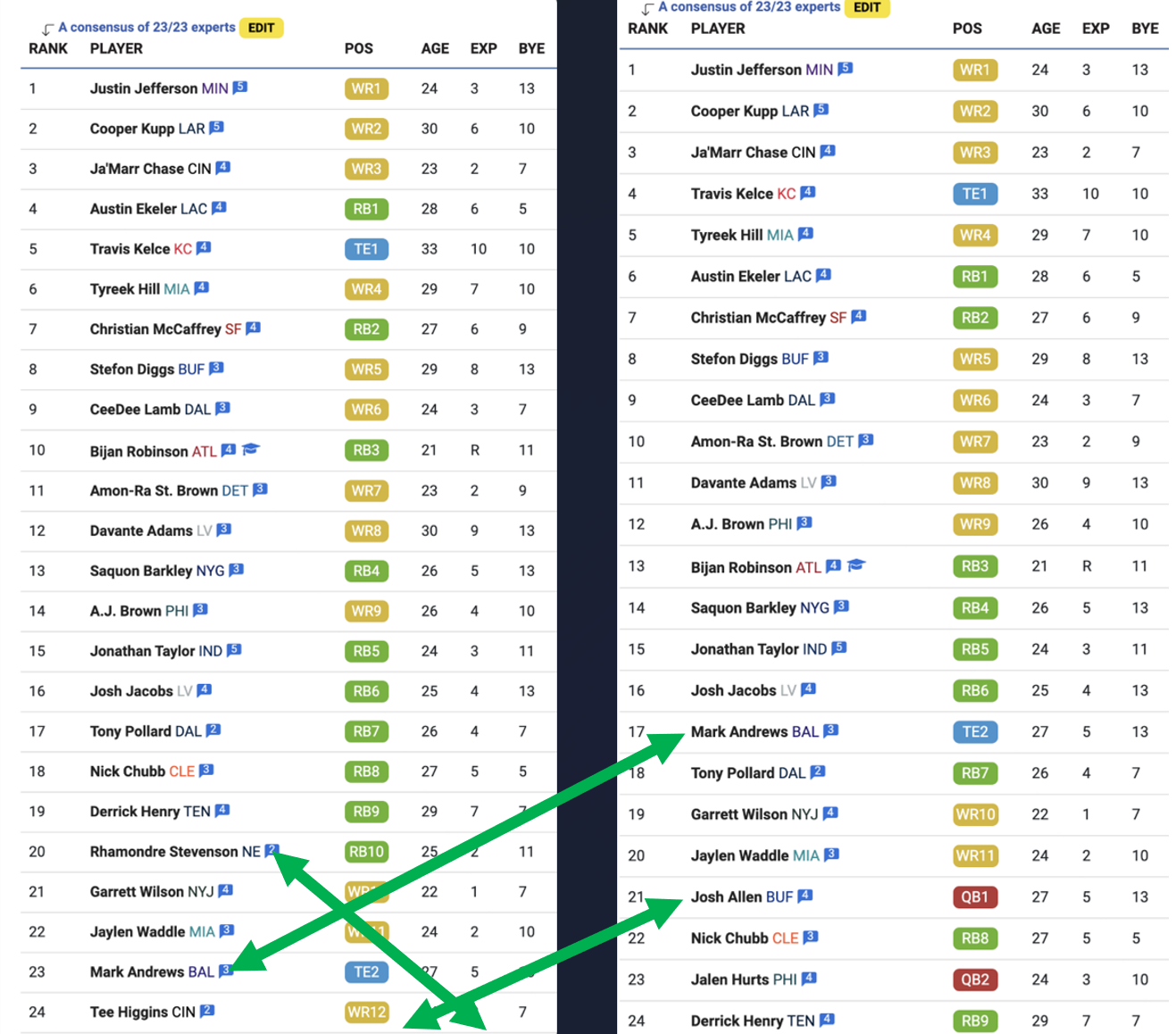Think back to years and years ago to the days when people drafted from a magazine with a dated, generic, non-specific cheatsheet. While some people do still bring magazines to drafts, today, many people still use a generic, non-specific set of rankings they've downloaded "from the internet." The only difference is it's not as dated as that magazine is.
But because it's a one-size-fits-all solution to a particular problem, the advice and your results are almost as bad.
Related: See how the wild scoring in Scott Fish Bowl makes things go haywire here >>>
Here's the hard truth. Once you project the stats, a player's value is largely determined by three things:
- Your specific scoring system.
- Your specific starting lineup requirements.
- Your specific number of teams in your league.
Those factors determine a player's value, factoring in the projected points scored against the supply and demand in the market. It's Economics 101. It's why diamonds and Travis Kelce are both so valuable.
There are countless ways a league's scoring system can affect who you should draft. Sometimes quarterbacks are worthless. Sometimes, they are the most sought-after position on the board. Other times, wide receivers should dominate. Some leagues have shifted their rules to find balance.
Here are four common rule tweaks with screenshots of our new Rankings Page that detail how the top of your draft board will change.
PPR versus Non-PPR
PPR stands for Point Per Reception. This means when a player catches a pass, they get a point. But it wasn't long ago that non-PPR scoring dominated the fantasy landscape. Over the last decade or so, many leagues have added this to their rule set.
Here's what it does to the top of the board.
PPR Top 24 vs. Non-PPR Top 24

A Look at Specific Players
Remember, the projections for these players don't change. Only the scoring system has changed.
- Ja'Marr Chase moves from 3rd to 9th.
- Christian McCaffrey moves from 7th to 1st.
- Nick Chubb moves from 18th to 6th.
General Takeaways
- In non-PPR scoring, running backs and quarterbacks are more valuable.
- In PPR scoring, wide receivers and tight ends are more valuable.
The Number of Teams in Your League
This is huge. Lots of leagues have 12 teams. Or 10 teams. But sometimes 8. Or maybe 14. Oh, there are 16-team leagues too. And on and on.
Here's a look at what happens when you change the number of teams in a Superflex (which is a league setting that allows each team to start two quarterbacks) league.
10-team Superflex vs. 16-team Superflex

A Look at Specific Players
Remember, the projections for these players don't change. Only the number of teams in your league has changed.
- Jalen Hurts has moved from 9th to 3rd.
- Lamar Jackson moves from 20th to 11th.
- Saquon Barkley moves from 15th to 22nd.
General Takeaways
- It's easy math to know that if 10 teams start two quarterbacks each, that's 20 quarterbacks, which in a 16-team league, that's 32 possible starters.
- Starting the 20th-best quarterback is okay. Starting the 32nd-best one is absolutely no fun.
- This makes quarterbacks far more valuable in 16-team Superflex leagues.
- That value comes mostly at the expense of running backs.
- Nine running backs make the top 24 in a 10-team league, but only four do when you move to 16 teams.
- Tight ends take a hit as well.
To Flex or Not to Flex
Similar to Superflex above, a flex position is an additional player in the starting lineup. Unlike the Superflex, the flex usually can only be a running back, wide receiver, or tight end. In a 12-team league with two starting running backs, three starting wide receivers, and a flex, the majority of the flex spots are taken up by running backs. Here's why:
- 12 teams with 2 starting RBs = 24 starting RBs
- 12 teams with 3 starting WRs = 36 starting WRs
- That means the 25th-best RB is competing for the flex spot with the 37th-best WR
- Generally, the 25-best RB will out-score the 37th-best WR
Look below to see how removing the flex position from your starting lineup affects the top of the board.
With a Flex Position vs. Without a Flex

A Look at Specific Players
Remember, the projections for these players don't change. Only the extra flex starter has changed.
- Mark Andrews moves from 23rd to 17th.
- Rhamondre Stevenson moves from 20th to unranked.
- Josh Allen moves from unranked to 21st.
General Takeaways
- Since the majority of flex spots are taken up by running backs, without the flex position, running backs will lose value.
- Conversely, without the extra non-quarterback starting position, quarterbacks gain value.
The Solution
We've got you covered. Here are three ways you can immediately apply these (and many more) principles to your own leagues:
- Rankings: Our new rankings page allows you to quickly adjust the league settings to match your own or import your league from your league website. The rankings shown will adjust according to your league settings using the strategies touched on in this article.
- Cheatsheets: Our cheatsheets serve the same purpose, presenting the rankings in a printable format that you can conveniently bring along to your draft. You can cross out players as the draft progresses.
- Draft Dominator: The math employed by the Draft Dominator goes beyond what is discussed in this article. It generates rankings not only at the start of the draft but also adjusts between each pick to cater to your roster's needs. The Draft Dominator is available online and as a mobile app.
By utilizing these resources and strategies, you can enhance your drafting approach and increase your chances of success in fantasy football leagues.
